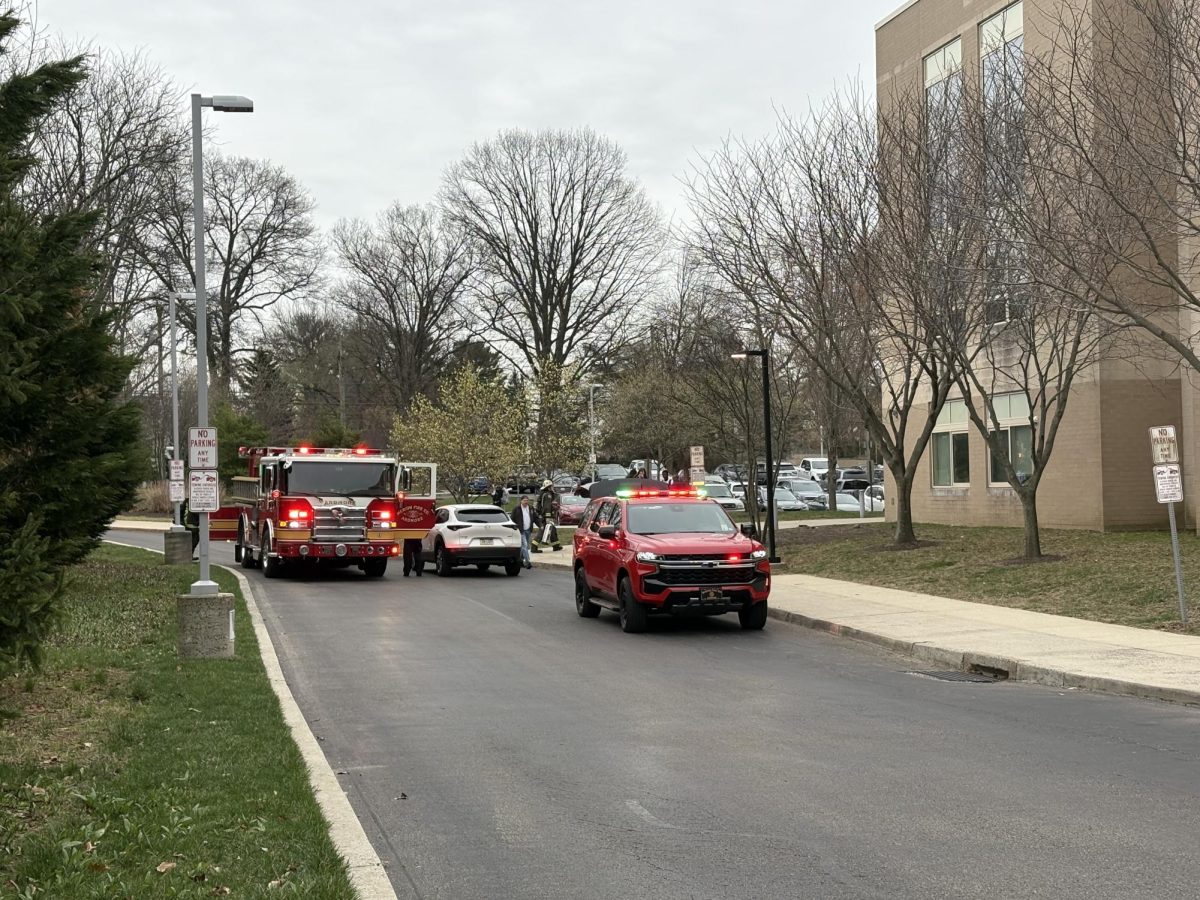On December 20, The Merionite published two student opinion articles on the Israeli-Palestinian conflict titled “Humanity’s true colors” and “There’s more to the story.” The former, “Humanity’s true colors,” was highly critical of the Israeli government’s treatment of the Palestinian people and ended with a call for readers to “stand against Israeli occupation of Palestine’s historic land and the disrespect and abuse of the Palestinian people for 75 years.” The latter, “There’s more to the story,” was featured on an adjacent page of the opinions section and discussed the conflict’s history from a pro-Israeli perspective. That morning, approximately 900 print copies were distributed to LM students and staff, and the articles were uploaded to The Merionite’s website. Upon publication, hundreds of members of the LM community reached out to both The Merionite and LMSD, expressing their concerns regarding the content and publication of “Humanity’s true colors.” Later that week, The Merionite received an email from Principal Dr. Michael Johnson requesting that the articles be taken down from its website, per the directive of Superintendent Dr. Steven Yanni. This request was made despite the fact that the district administration had previously approved the publication of both “Humanity’s true colors” and “There’s more to story” for the December issue. As a result of this directive, The Merionite complied and removed both opinion pieces from its website on Friday, December 22.
Dr. Yanni says that he received approximately 250 emails from concerned community members, and estimates that ninety percent of those emails were about the content of “Humanity’s true colors.” In addition to pointing out perceived inaccuracies within the article, these reactions ranged from criticisms of The Merionite and LMSD for allowing its publication, to calls for punishment of the author, with some even labeling it a “pro-Hamas article.” The majority of these messages came from parents and other community members, with “about a dozen reach-outs from students and a few more from staff.” In particular, the article’s ending was a frequent target of criticism, as some community members felt that “the call to action was really a call to violence,” Yanni explained.
Eventually, over concerns of both student safety and well-being as well as community accusations of antisemitism, Yanni directed The Merionite to take both articles down from its website. “I really thought it was important to take the articles down for the well-being of everyone, largely because there was so much hurt and fear, and on top of that, we were getting ready to go off on winter break, where kids weren’t going to have access to their counselors for ten days,” he explained, after noting the importance of student voice and expression. “A significant number of students and staff view much of the language as antisemitic. As such, I am concerned that our Jewish and Israeli students and staff (and others) will continue to feel marginalized, discriminated against, and potentially, unsafe,” he wrote in a subsequent communication with The Merionite.
Regarding student safety, Yanni shared that the district received emails from multiple community members, students, and teachers who were made uncomfortable by the contents of “Humanity’s true colors.” Also “there were a number of emails that came through right after the article’s publication which were speaking about the student [author] in a very negative way.” Various accounts on X, formerly Twitter, also began disseminating the article, leading to disparaging and threatening comments being directed at the author and LMSD. One even included a comment which leaked the entirety of LMHS’s staff directory, seemingly encouraging users to contact them. A couple of these posts were viewed and interacted with by thousands of people, and the superintendent even mentioned that the article’s link reached a former colleague who was living in New Zealand.
“Humanity’s true colors” and “There’s more to the story” were initially intended to be published in the November issue after multiple students reached out following Hamas’ attack on October 7. However, as explained by a letter from The Merionite’s Editors-In-Chief published in place of these articles, “unfounded claims about the contents of this article were irresponsibly spread among the school community prior to even the initial stages of editing the article,” which led to “texts, emails, and intimidating phone calls staunchly opposing the article’s publication, spreading misinformation and rumors about the article’s contents, and calling into question The Merionite’s continuation as a publication.” The school, district administration, and counselors were all contacted by concerned members of the community, many of whom were unaware of what was actually said within the article, which was still in the middle of the editing process. After seeing this overwhelmingly negative reaction, editors of The Merionite communicated with the authors of both pieces and their families. At that point, the family of “Humanity’s true colors” had decided not to publish the article.
Still, given the significance of the topic, the author and their family later requested that “Humanity’s true colors” be published in the December issue. In preparation for that issue, The Merionite edited both “Humanity’s true colors” and “There’s more to the story” thoroughly to ensure that their content was suitable for publication, while still allowing the students to freely express their opinions. Both articles were also shared with Dr. Johnson and were reviewed by district personnel, including the superintendent and district solicitor, who determined that both articles were forms of constitutionally protected speech. The articles were then published with the approval of the writers’ families.
On the day of the articles’ publication, LMSD released a statement on their website affirming the district’s support for free speech of it’s students. “The Lower Merion School District condemns both antisemitic and anti-Islamic rhetoric and actions. At the same time, as noted in District Policy 235, the District supports and values students’ First Amendment rights to free speech and free expression in publications,” it said. As the section of District Policy 235 concerning students’ freedom of expression outlines, “expression that is likely to or does materially and substantially interfere with the educational process, threatens serious harm to the school or community, encourages unlawful activity, or interferes with another individual’s rights is prohibited by the District, in accordance with State regulations.” The letter then concluded by stating, “The Lower Merion School District will continue to strive to empower student voice and agency, to promote civil discourse necessary to [the] understanding of diverse viewpoints, and to ensure a sense of safety and belonging for all students.”
In response to reactions from students and families following the December 20 publication, a second letter was emailed out to the community on December 21. Signed by Yanni, this letter instead started off by “acknowledging the hurt and fear that the most recent edition of The Merionite, Lower Merion High School’s student newspaper, has caused among some members of our community.” It stated that LMSD’s legal counsel had confirmed that the article was a form of constitutionally protected speech. Yanni adknowledged that “although it was not the intent of the District, The Merionite, LMHS, or any of its students or staff to create hurt and fear, that is what has occurred for many people in our community” and that factors such as student and staff safety and respect for the concerns of students and families had to be considered. Yanni also outlined three main goals to pursue following winter break. The first of these was to clearly communicate the “differences between Constitutionally protected speech and hate speech.”Since then, the district has published a new standardized definition of antisemitism, adopted from the International Holocaust Remembrance Alliance (IHRA)’s definition by LM students and teachers. The definition was published on LMSD’s Making Practices Public page, along with the district’s existing definition of Islamophobia, which uses the same working definition and examples as the Pennsylvania Human Rights Commission. For the other two goals, the district also resolved to provide learning resources and opportunities about antisemitism and Islamophobia for students and staff, and to continuously reevaluate the district’s curriculum to ensure inclusivity.
In mid-January, following winter break, the Editors-In-Chief of The Merionite met with the superintendent to discuss the decision to remove the articles and the possibility of reuploading them. Due to continuing concerns regarding antisemitism, student safety and well-being, and errors of both fact and omission, he urged The Merionite to refrain from reuploading the digital versions of the articles. In a memo addressed to The Merionite’s editors and staff, he said, “the article’s author will likely face repercussions from fellow students,” if the article was republished. Yanni also reiterated that some students, staff members and families interpreted language contained in the article to be antisemitic. Over the winter break, The Merionite editors reviewed each of the articles and the sourcing for the articles carefully. It was determined that there were two factual inaccuracies in “Humanity’s true colors.” The article mentioned that the Palestinian Liberation Organization (PLO) was created in 1967. The PLO was actually created in 1964, but only rose to prominence in 1967 following the Six-Day War. Additionally, the article stated that “there isn’t any Hamas” in the West Bank. However, Hamas does maintain a presence in the West Bank, although it is not in political control there.
When speaking about errors by omission, Yanni said, “There was some information left out of [the article “Humanity’s true colors”] that did not provide a comprehensive understanding of why the author felt the way that she did.” By this standard, The Merionite identified examples of selective omission in both articles, but did not feel that it would be reasonable to require a comprehensive account of the history of the Israeli-Palestinian conflict within these opinion pieces before publishing them. Additionally, it is not The Merionite’s policy or past practice to require articles, editorials or otherwise, to contain all background—a standard which the editors-in-chief believe would be virtually impossible to meet. Ultimately, The Merionite decided not to republish the articles online, both due to the formal request by Dr. Yanni and the general sentiment that the paper’s primary audience of LM students and staff was reached in December with the distribution of that issue. Finally, concerns about potential hostilities directed at each of the writers raised concerns about republishing. Going forward, The Merionite’s editors and staff say they will continue to pursue their mission, which is “to provide a space for student voice and to explore topics that are relevant to the lives of the student body.”
Following the adoption of the IHRA definition, LMSD now officially defines antisemitism as “a certain perception of Jews, which may be expressed as hatred toward Jews. Rhetorical and physical manifestations of antisemitism are directed toward Jewish or non-Jewish individuals and/or their property, toward Jewish community institutions and religious facilities.” The definition then goes on to list several examples of antisemitic acts, such as denying the Holocaust or “calling for, aiding, or justifying the killing or harming of Jews in the name of a radical ideology or an extremist view of religion.” The push for a clear definition was spearheaded by LM social studies teacher Mark Levy. According to Ilana Zahavy ’24, one of the students involved in the project, Levy reached out to Jewish students from across LM to work towards establishing an in-depth definition of antisemitism district-wide. Levy and the students discussed what they would want out of a definition, before settling on the working definition created by the IHRA. This definition is also used by the U.S. State Department, foreign governments, and major organizations.
Many, like Eliza Castello ’24, a student involved in the change, are relieved the district has finally moved towards a firm and in-depth definition of antisemitism. Castello is hopeful about the new definition, explaining that “after meeting with Dr. Yanni and thoroughly discussing the topic, it is clear to many of the students that our voices were heard. I am very much glad that this definition was implemented.” For Castello and some other Jewish students, this definition may serve to create a feeling of safety, as well as clarity on antisemitism’s exact definition. She also believes this serves as a testament to student voice, showing how organized groups of students and teachers can shape district policy. Along with these successes, Castello also expressed regret that it had taken so much effort from students and teachers to get a definition created, adding that “I do wish it had been in the bylaws many years before this.”
But the change does not come without criticism. Some students are afraid it is overly broad and could silence legitimate free speech. While recognizing the importance of adopting a definition as a step against discrimination, Oren Goldberg ’25 worries that the IHRA definition perpetuates “the notion that criticizing Israel, or suggesting that Israel exists on some faulty premises, is equivalent to violent actions,” which could overly broaden the meaning of antisemitism. Of the definition’s eleven examples of an-tisemitism, seven explicitly mention Israel. Some of these examples have come under fire on an international scale, including in an open letter to the United Nations from 104 different Israeli and international human rights groups, who mention in the letter that “the IHRA definition has often been used to wrongly label criticism of Israel as antisemitic, and thus chill and sometimes suppress non-violent protest, activism, and speech critical of Israel.” Those concerned worry some of the examples define antisemitism too broadly, making it hard to differentiate legitimate speech from antisemitism. “It creates a really dangerous set of premises that automatically shut down any form of dissent,” says Goldberg.
Regardless of these criticisms, the district aims to use the incorporation of the IHRA definition to increase clarity around antisemitism. Yanni, while speaking at the January 31 meeting of LMSD’s Equity and Anti-Racism subcommittee, highlighted the need for clarity by explaining that in recent months, “what really came to light was a pretty significant misunderstanding of what antisemitism is.” Yanni shared that LMSD is currently training staff around preventing and responding to antisemitism and that the district plans to create “learning opportunities” for students surrounding what antisemitism is.
Yanni also traced this misunderstanding to a lack of education, saying that “It’s glaring, not just in PA public schools, but in many states across the country, how littleMiddle Eastern history is taught.” To remedy this, Assistant Superintendent Dr. Alexis McGloin is working to reexamine how Jewish history is taught in schools. McGloin met with 10th and 11th grade social studies teachers to discuss how LMSD teaches Jewish, Middle Eastern, and Holocaust history. McGloin also plans to devote time this summer to exploring how those topics are incorporated into the curriculum and having “some more conversations about moving Holocaust education into the middle level.” Holocaust education currently does not officially start until students enter high school.
According to Yanni, the district wants “to make sure, when there is gap knowledge in our district, whether that gap knowledge is among adults, or among students, or among the community, that we provide education around that,” and this new definition and possible curriculum changes are in service of that goal. When asked if anything written in “Humanity’s true colors” would be classified as antisemitic under the updated definition, Yanni said, “The concern, internally and externally, is that there were parts of the article where it wasn’t clear if it was criticism of Israel or of the Jewish people.” Still, Yanni was emphatic that he not want to label anyone as antisemitic.







